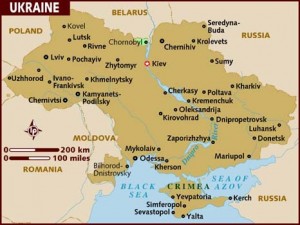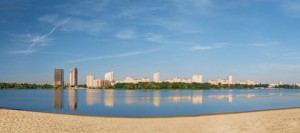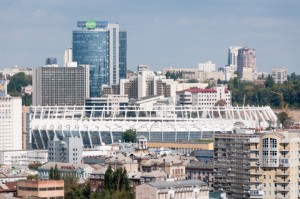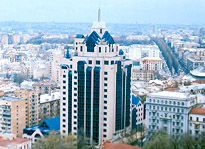
[Updated Oct 2020] A guide to serviced offices and office space for rent in Kiev as well as general information that may be useful if you are thinking of renting office space in Kiev.
For further offices information or to search office space for rent in Kiev just click. Or contact us for any other office space query.
History & Geography
Located on the banks of the Dnieper River, Ukraine’s capital city is one of the oldest and most diverse cities in Eastern Europe. Kiev is the largest city in Ukraine and is to be found in the heavily forested north of the country. Including the Dnieper, which flows through the city, Kyiv has 448 open bodies of water within its limits, made up of ponds, lakes and tributaries. Kiev has played an important role in Eastern Europe since it was settled in 482 CE by various Slavic tribes. During the eighth and ninth centuries, the city functioned as an outpost of the Khazar empire and later fell under the influence of Varangian nobility. The city changed hands several times over the next few centuries between the Slavs, Lithuanians and Poles. In 1654 it finally became part of the Tsardom of Russia. While the city functioned as an important Christian centre during this time its influence on commerce and politics was negligible. In the 18th and 19th centuries, Kyiv was dominated by the Russian military and the Russian Orthodox Church. The 19th century saw many Russians immigrate to Kiev and gradually push the native Ukrainians to the outskirts of the city. When Russia underwent its industrial revolution Kiev became important commercially, developing significant manufacturing industry. Soon the city was the third most important in the Russian Empire. After the Russian Revolution, Soviet industrialization continued to transform the city, which eventually became a centre of commerce, industry, science and technology. Kyiv suffered badly in WWII when it was occupied by the German army and severely damaged by bombing and artillery. After the war, however, the city continued to prosper. The 1986 Chernobyl disaster occurred only 62 miles north of the city, however luckily a prevailing north wind blew the nuclear debris away from Kiev. After the fall of the Soviet Union Ukraine was proclaimed as independent in 1991 and Kiev was named the capital of the new country. Since that time the city has continued to reinvent itself and move forward.
 Economy
Economy
As one would expect of a capital city Kiev is the administrative, cultural and scientific centre of Ukraine. Recent figures have shown that Kiev’s economy is growing 11 percent faster than the rest of the country’s. Kiev has a wide and diverse economic base and this has been one of the reasons that the city’s unemployment rate is historically low. Kiev has a thriving real estate industry and apartments in the city are among the most expensive in Eastern Europe. Most large businesses based in Ukraine such as Naftogaz Ukrainy, Energorynok and Kyivstar have their headquarters in Kiev, which also has a large commercial real estate industry, with the country’s tallest office buildings and largest shopping malls located in the city. The largest industries in the city are utilities, manufacturing of food, beverage and tobacco products, chemical and mechanical engineering, publishing and printing. Recently the city authorities devised a 15-year development plan for the city which intends to full modernize every facet of its infrastructure in order to make it more attractive to businesses and tourists. The plan calls for EUR 82 billion of foreign investment by the year 2025.
 Tourism
Tourism
In 2005 Ukraine introduced a visa-free system for members of the EU and Switzerland, making it much easier to visit the country. And while Ukraine has never been a traditional tourist destination this is slowly changing. Since the visa decision, Ukraine, and more specifically Kyiv has seen a notable rise in visitors. Before the financial crisis the city was seeing an average annual growth in visitors of 23 percent, and in 2009 1.6 million tourists visited the city. It is set to jointly host the UEFA European Football Championships in the summer of 2012 with neighbouring Poland which will provide even more visitors. Those who do come to Kiev quickly realise it is a rapidly advancing city with lots to see. It is one of the lushest city’s in Eastern Europe, and it is said that in the summer it is hard to escape the shade of its trees, especially the ubiquitous horse chestnuts. Because of the numerous lakes and river tributaries, Kiev has many islands, the most popular of which is Venetsianskyi with its popular Hydropark which includes boat rentals, beaches, an amusement park and nightclubs. Kiev also boasts a plethora of beaches and parks, with Victory Park being often frequented by strollers, joggers and cyclists. In winter the city’s lakes and rivers freeze over and are visited by ice-skaters and fishermen. But it is summer when the city is most lively, and Independence Square turns into a centre of nightlife with people thronging the nearby clubs, bars, cafes and restaurants that are influenced by such a range of varied cultures from American to Uzbek. For history and culture buffs Kiev has many striking churches and monasteries as well as many museums, including the Museum of the Great Patriotic War, which is a must-see for its sheer size, detail and splendour upon which the titanium Mother Motherland Statue standing at 203ft tall.
 Transportation
Transportation
Kiev is served by a metro, buses, trolleybuses, trams and funicular. The transportation system in the city isn’t well maintained, especially the buses, though it’s being expanded and revamped constantly. The metro system is undoubtedly the best way to get around the city, as it is fairly fast, cheap and reliable. However, visitors may want a ride on the funicular, which climbs the right bank of the Dnieper. Kiev’s tram system, once a popular and well-maintained transport option, is being phased out. The city’s taxi system is unregulated and chaotic, with varying prices. Locals often operate as taxi drivers on an ad hoc basis. Kiev Passenger Railway System serves the city regarding long-distance train travel, though construction is underway on a new station on the left bank of the Dnieper which once completed is to serve as the city’s main long-distance transport hub. Two airports serve the city, Boryspil Airport, which is mainly used for longer flights and Zhulyanov Airport, which sees mostly domestic flights or flights to neighbouring countries.

Office space to rent in Kiev
Kiev is currently recovering slowly from the economic crisis. Unemployment in the city is currently at 7.7 percent, down from 8.1 percent at the end of 2010. According to CBRE the vacancy rate in Kiev in June 2011 was 13 percent. The average rent for Grade A office space in the city is approximately USD 35 per square metre per month. The CBD and most of the city’s prime office space is located on the left bank of the river, however, new projects are currently being built on the right bank.
We carry out a free office search and our advisory and acquisition services are also free, always. Our Kiev office space brokers and agents are globally regulated by the Royal Institution of Chartered Surveyors (RICS) ensuring the highest standards of commercial property advice and service at all times.

The Office Providers are Regulated by the Royal Institution of Chartered Surveyors (RICS)